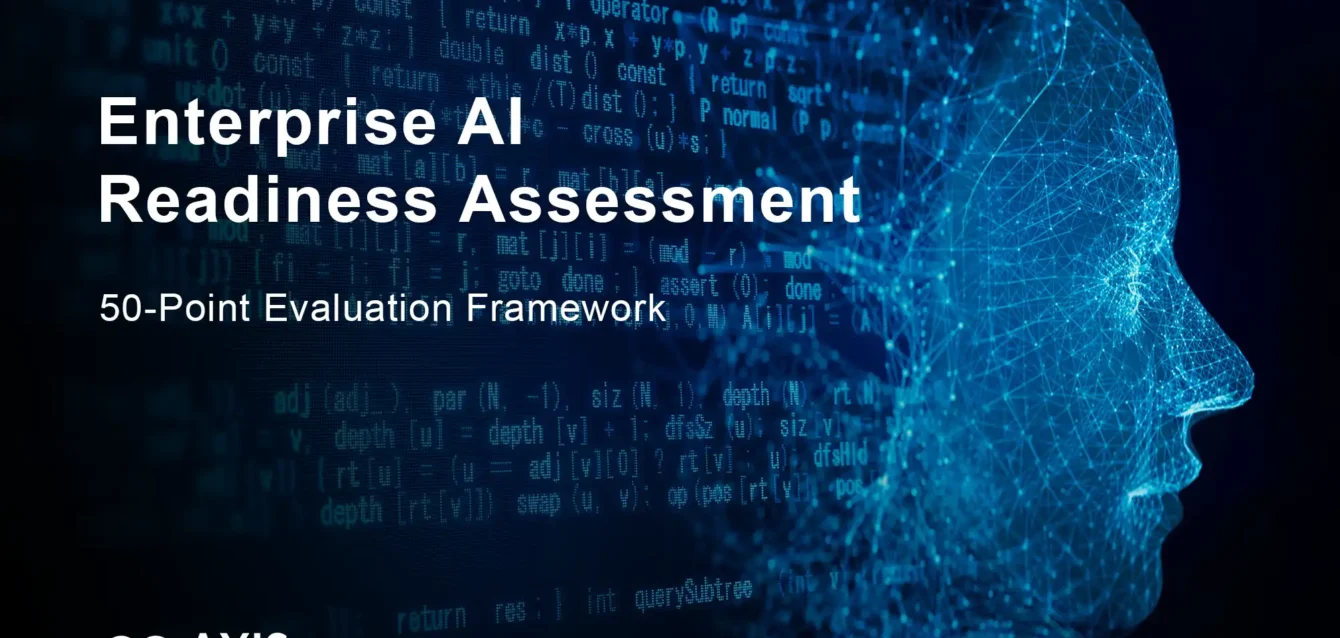Enterprise AI Readiness Assessment
Only 13% of enterprises globally are truly ready to leverage artificial intelligence to its full potential, according to Cisco’s 2024 AI Readiness Index. Yet here’s what’s fascinating: organizations that complete a systematic AI readiness assessment are 3.2 times more likely to achieve meaningful ROI from their AI investments within the first 18 months.
The challenge isn’t just about having the latest technology or hiring data scientists. It’s about understanding the intricate web of organizational factors that determine whether your AI initiatives will transform your business or become expensive experiments that never scale beyond proof-of-concept.
This isn’t another surface-level checklist. What you’re about to read is the most comprehensive enterprise AI readiness assessment framework available anywhere—a 50-point evaluation system developed through analysis of successful AI implementations across Fortune 500 companies and emerging best practices from 2025’s leading organizations.
By the end of this guide, you’ll have a clear roadmap for evaluating your organization’s AI maturity and a precise action plan for addressing capability gaps before they derail your initiatives.
Table of Contents
- Understanding Enterprise AI Readiness
- The 50-Point Assessment Framework
- Strategic Foundation Assessment (10 Points)
- Data Infrastructure Evaluation (10 Points)
- Technology Architecture Assessment (10 Points)
- Organizational Capability Analysis (10 Points)
- Governance and Compliance Framework (10 Points)
- Assessment Scoring and Maturity Levels
- Industry-Specific Considerations
- Implementation Roadmap Development
- Common Assessment Pitfalls and How to Avoid Them
- Measuring Progress and Continuous Improvement
Understanding Enterprise AI Readiness {#understanding}
Enterprise AI readiness represents far more than technical capability. It’s the composite state of your organization’s strategy, infrastructure, data quality, talent pool, governance framework, and cultural adaptability that determines your ability to deploy artificial intelligence solutions at scale.
The Hidden Reality of AI Implementation
Here’s what most assessment frameworks miss: 78% of organizations report using some form of AI, but barely one-third have moved beyond isolated pilot projects. The difference between those who scale successfully and those who remain stuck in pilot purgatory comes down to readiness across five critical dimensions.
Why Traditional Assessments Fall Short
Most existing AI readiness evaluations focus heavily on technical infrastructure while glossing over the organizational and cultural factors that actually determine implementation success. A company might have world-class data architecture and powerful computing resources, yet fail to achieve meaningful AI adoption because they haven’t addressed change management, stakeholder alignment, or governance frameworks.
The Five Pillars of AI Readiness
Strategic Alignment: Your AI objectives must connect directly to measurable business outcomes. Organizations with clearly defined AI strategies linked to specific KPIs are 2.5 times more likely to achieve successful scaling.
Data Foundation: Quality, accessible, and well-governed data serves as the fuel for AI systems. But data readiness goes beyond volume—it requires structured processes for data collection, cleaning, validation, and continuous monitoring.
Technology Infrastructure: Modern AI workloads demand dynamic, scalable computing resources. This includes not just raw processing power, but also the orchestration tools, APIs, and integration capabilities that enable AI systems to work within existing business processes.
Organizational Capability: People and processes ultimately determine AI success. This encompasses technical skills, change management capabilities, cross-functional collaboration, and leadership commitment to long-term AI transformation.
Governance and Risk Management: As AI systems become more autonomous and influential in business decisions, robust governance frameworks become essential for managing bias, ensuring compliance, and maintaining stakeholder trust.
The 50-Point Assessment Framework {#framework}
The framework evaluates your organization across 50 specific criteria, each weighted according to its impact on successful AI implementation. Unlike basic checklists that treat all factors equally, this assessment recognizes that certain capabilities are prerequisites for others.
Assessment Methodology
Each of the 50 evaluation points uses a 4-level maturity scale:
Level 1 – Initial (1 point): Basic awareness exists, but no formal processes or systematic approach.
Level 2 – Developing (2 points): Some processes in place, but inconsistent application and limited measurement.
Level 3 – Defined (3 points): Standardized processes with regular measurement and continuous improvement.
Level 4 – Optimized (4 points): Advanced capabilities with data-driven optimization and industry-leading practices.
Your total score (50-200 points) determines your overall AI readiness maturity level and guides prioritization of improvement efforts.
Scoring Framework Overview
- 50-80 points: Foundation Building Required
- 81-120 points: Selective Implementation Ready
- 121-160 points: Scaled Deployment Ready
- 161-200 points: Innovation Leadership Level
Strategic Foundation Assessment (10 Points) {#strategic}
Strategic readiness forms the cornerstone of successful AI implementation. Organizations that attempt to deploy AI without clear strategic alignment inevitably struggle with resource allocation, stakeholder buy-in, and measuring success.
1. AI Vision and Business Case Development
Evaluation Criteria: Does your organization have a clearly articulated AI vision that connects to specific business outcomes?
Level 4 Example: AI strategy document explicitly links each proposed use case to measurable business metrics, with detailed ROI projections and risk assessments updated quarterly based on pilot results.
Level 1 Example: General recognition that “AI could be helpful” but no specific use cases identified or business case developed.
2. Executive Leadership Commitment and Sponsorship
Evaluation Criteria: How actively does senior leadership champion and resource AI initiatives?
Leadership commitment goes beyond verbal support. Look for evidence of budget allocation, time investment in AI education, and willingness to make organizational changes required for AI success.
3. Cross-Functional AI Team Formation
Evaluation Criteria: Have you established a dedicated, cross-functional team responsible for AI strategy and implementation?
Successful AI teams typically include business domain experts, data scientists, infrastructure engineers, change management specialists, and legal/compliance representatives.
4. Investment Strategy and Budget Allocation
Evaluation Criteria: Is there a clear investment strategy with allocated budget for AI initiatives?
This includes not just technology costs, but also training, consulting, change management, and ongoing operational expenses.
5. Success Metrics and KPI Framework
Evaluation Criteria: Are there defined metrics for measuring AI initiative success?
Metrics should include both technical performance indicators (model accuracy, latency, uptime) and business impact measures (cost reduction, revenue increase, customer satisfaction improvement).
6. Risk Management and Mitigation Strategy
Evaluation Criteria: Have you identified and planned for AI-related risks?
Consider technical risks (model failure, data quality issues), business risks (competitive response, market changes), and regulatory risks (compliance requirements, liability concerns).
7. Stakeholder Alignment and Communication Plan
Evaluation Criteria: Is there a structured approach to maintaining stakeholder alignment throughout AI initiatives?
This includes regular communication schedules, feedback mechanisms, and processes for addressing concerns and resistance.
8. Competitive Positioning and Market Analysis
Evaluation Criteria: Do you understand how AI fits into your competitive landscape?
Organizations should analyze competitor AI capabilities, identify differentiation opportunities, and understand industry benchmarks for AI adoption.
9. Long-term AI Roadmap Development
Evaluation Criteria: Have you developed a multi-year roadmap for AI capabilities evolution?
Roadmaps should account for technology evolution, changing business needs, and lessons learned from initial implementations.
10. Vendor and Partnership Strategy
Evaluation Criteria: Is there a clear strategy for working with AI vendors, consultants, and technology partners?
This includes evaluation criteria for vendor selection, partnership models, and knowledge transfer requirements.
Data Infrastructure Evaluation (10 Points) {#data}
Data serves as the foundation for all AI systems. Poor data quality, inaccessible data silos, or inadequate data governance can derail even the most sophisticated AI implementations.
11. Data Quality and Completeness Assessment
Evaluation Criteria: What is the current state of your data quality across key business systems?
Data quality encompasses accuracy, completeness, consistency, timeliness, and validity. Organizations should have systematic processes for measuring and improving data quality.
12. Data Accessibility and Integration Capabilities
Evaluation Criteria: How easily can data be accessed and combined across different systems and sources?
Modern AI applications often require data from multiple sources. Assess your ability to integrate structured and unstructured data from various systems, databases, and external sources.
13. Data Architecture and Scalability
Evaluation Criteria: Is your data architecture designed to support AI workloads at scale?
AI systems often require different data architecture patterns than traditional business intelligence applications. Consider data lakes, real-time streaming capabilities, and cloud-native architectures.
14. Master Data Management and Data Governance
Evaluation Criteria: Are there established processes for managing master data and ensuring data governance?
Strong data governance includes data ownership, access controls, data lineage tracking, and compliance with regulatory requirements.
15. Real-time Data Processing Capabilities
Evaluation Criteria: Can your organization process and analyze data in real-time or near-real-time?
Many AI applications require real-time decision making. Assess your streaming data capabilities, event processing systems, and latency requirements.
16. Data Security and Privacy Controls
Evaluation Criteria: Are robust security and privacy controls in place for data used in AI systems?
This includes encryption, access controls, audit trails, and compliance with regulations like GDPR, CCPA, and industry-specific requirements.
17. Data Cataloging and Metadata Management
Evaluation Criteria: Is there a comprehensive catalog of available data assets with rich metadata?
Data catalogs help AI teams discover relevant data sources and understand data context, lineage, and quality characteristics.
18. Historical Data Availability and Retention
Evaluation Criteria: Do you have sufficient historical data to train and validate AI models?
Most AI models require substantial historical data for training. Assess data retention policies and historical data availability across key business processes.
19. External Data Integration Capabilities
Evaluation Criteria: Can you easily integrate external data sources to enhance AI models?
Many successful AI applications combine internal data with external sources like market data, weather information, social media, or industry benchmarks.
20. Data Pipeline Development and Management
Evaluation Criteria: Are there established processes for building and managing data pipelines that support AI workflows?
Data pipelines for AI often have different requirements than traditional ETL processes, including support for unstructured data, real-time processing, and model training workflows.
Technology Architecture Assessment (10 Points) {#technology}

Your technology infrastructure must support the computational demands of AI workloads while integrating seamlessly with existing business systems.
21. Computing Infrastructure and Scalability
Evaluation Criteria: Does your computing infrastructure support AI workloads with appropriate scalability?
AI training and inference can be computationally intensive. Assess your current compute capacity, GPU availability, and ability to scale resources dynamically.
22. Cloud Strategy and Hybrid Architecture
Evaluation Criteria: Do you have a clear strategy for leveraging cloud resources for AI workloads?
Most organizations benefit from hybrid approaches that combine on-premises and cloud resources. Consider data residency requirements, cost optimization, and vendor flexibility.
23. API Development and Integration Framework
Evaluation Criteria: Are there established capabilities for developing and managing APIs that support AI applications?
AI systems often need to integrate with multiple business applications through APIs. Assess your API management capabilities, documentation standards, and security practices.
24. DevOps and MLOps Capabilities
Evaluation Criteria: Are DevOps practices adapted to support machine learning and AI development lifecycles?
MLOps extends DevOps concepts to machine learning, including model versioning, automated testing, deployment pipelines, and monitoring.
25. Security Architecture for AI Systems
Evaluation Criteria: Is your security architecture designed to protect AI systems and their outputs?
AI systems introduce new security considerations including model security, adversarial attacks, and protecting sensitive training data.
26. Network Architecture and Bandwidth
Evaluation Criteria: Does your network infrastructure support the data transfer requirements of AI systems?
AI applications often involve moving large datasets and require low-latency access to data and compute resources.
27. Storage Systems and Data Management
Evaluation Criteria: Are storage systems optimized for AI workloads?
AI systems often require different storage patterns than traditional applications, including support for large files, high-throughput access, and long-term archival.
28. Monitoring and Observability Tools
Evaluation Criteria: Are there tools and processes for monitoring AI system performance and behavior?
AI systems require specialized monitoring for model performance, data drift, and business impact measurement.
29. Backup and Disaster Recovery for AI Systems
Evaluation Criteria: Are AI systems included in backup and disaster recovery planning?
Consider protection of training data, model artifacts, configuration settings, and business continuity requirements.
30. Integration with Existing Enterprise Systems
Evaluation Criteria: How well can AI systems integrate with your existing enterprise applications?
Successful AI implementations often require tight integration with CRM, ERP, and other business systems.
Organizational Capability Analysis (10 Points) {#organizational}
People and organizational processes ultimately determine AI success. Technical capabilities mean nothing without the human infrastructure to support them.
31. AI Skills and Competency Assessment
Evaluation Criteria: What is the current level of AI skills and competencies across your organization?
Assess technical skills (data science, machine learning, programming) and business skills (AI strategy, change management, project management).
32. Training and Development Programs
Evaluation Criteria: Are there systematic programs for developing AI capabilities across the organization?
Consider both technical training for IT staff and AI literacy programs for business users and executives.
33. Change Management Capabilities
Evaluation Criteria: Does your organization have strong change management capabilities to support AI transformation?
AI implementations often require significant changes to business processes, roles, and decision-making approaches.
34. Cross-functional Collaboration Practices
Evaluation Criteria: How effectively do different departments collaborate on complex, cross-functional initiatives?
AI projects typically require close collaboration between IT, business units, legal, compliance, and other functions.
35. Project Management and Execution Capabilities
Evaluation Criteria: Are there proven project management capabilities for complex technology initiatives?
AI projects often involve uncertainty, iteration, and coordination across multiple workstreams.
36. Knowledge Management and Documentation
Evaluation Criteria: Are there systematic approaches to capturing and sharing knowledge from AI initiatives?
Organizations should document lessons learned, best practices, and institutional knowledge to avoid repeating mistakes.
37. Innovation Culture and Risk Tolerance
Evaluation Criteria: Does your organizational culture support innovation and appropriate risk-taking?
AI initiatives involve experimentation and learning from failure. Assess cultural readiness for iterative development and intelligent risk-taking.
38. Performance Management and Incentive Alignment
Evaluation Criteria: Are performance management systems aligned to support AI initiatives?
Consider whether employee incentives and performance metrics support collaboration, learning, and long-term thinking required for AI success.
39. External Expertise and Consulting Capabilities
Evaluation Criteria: Do you have access to external AI expertise when needed?
Most organizations benefit from selective use of external consultants, vendors, and advisors to supplement internal capabilities.
40. Recruitment and Retention of AI Talent
Evaluation Criteria: Can your organization attract and retain the AI talent needed for success?
Consider compensation competitiveness, career development opportunities, and cultural factors that influence AI talent decisions.
Governance and Compliance Framework (10 Points) {#governance}
As AI systems become more autonomous and influential in business decisions, robust governance becomes essential for managing risk and maintaining stakeholder trust.
41. AI Ethics and Responsible AI Framework
Evaluation Criteria: Are there established principles and processes for ensuring ethical AI development and deployment?
Consider bias detection and mitigation, fairness requirements, transparency obligations, and social impact assessment.
42. Regulatory Compliance and Legal Framework
Evaluation Criteria: Are AI initiatives designed to comply with relevant regulations and legal requirements?
This includes industry-specific regulations, data protection laws, and emerging AI-specific legislation.
43. Model Governance and Validation Processes
Evaluation Criteria: Are there systematic processes for validating AI models before deployment?
Model governance includes testing for accuracy, bias, robustness, and business alignment before production deployment.
44. Data Privacy and Protection Measures
Evaluation Criteria: Are robust privacy protection measures in place for AI systems?
Consider data minimization, purpose limitation, consent management, and privacy-preserving techniques.
45. AI System Audit and Compliance Monitoring
Evaluation Criteria: Are there processes for ongoing audit and compliance monitoring of AI systems?
AI systems can change behavior over time, requiring continuous monitoring and compliance validation.
46. Risk Assessment and Management Framework
Evaluation Criteria: Is there a comprehensive framework for identifying and managing AI-related risks?
Consider technical risks, business risks, reputational risks, and regulatory risks.
47. Incident Response and Crisis Management
Evaluation Criteria: Are there established procedures for responding to AI system failures or incidents?
AI incidents can have significant business impact, requiring rapid response and communication capabilities.
48. Vendor Management and Third-party Risk
Evaluation Criteria: Are there processes for managing risks associated with AI vendors and third-party providers?
Consider data sharing agreements, liability allocation, and service level agreements.
49. Documentation and Record-keeping Standards
Evaluation Criteria: Are AI systems and decisions properly documented for audit and compliance purposes?
Documentation should include model development processes, training data sources, validation results, and deployment decisions.
50. Governance Committee and Decision-making Structure
Evaluation Criteria: Is there a clear governance structure for making decisions about AI initiatives?
Consider executive oversight, technical review committees, and stakeholder representation in AI governance.
Assessment Scoring and Maturity Levels {#scoring}

Maturity Level Definitions
Foundation Building (50-80 points) Organizations at this level have basic awareness of AI potential but lack systematic approaches to implementation. Focus should be on developing strategy, building foundational capabilities, and conducting small-scale pilots.
Key Characteristics:
- Limited AI strategy or vision
- Inconsistent data quality and accessibility
- Basic technology infrastructure
- Minimal AI skills and experience
- Ad-hoc governance approaches
Recommended Actions:
- Develop comprehensive AI strategy
- Conduct data quality assessment and improvement
- Invest in basic AI training and skills development
- Establish governance framework foundations
- Begin with low-risk pilot projects
Selective Implementation (81-120 points) Organizations can successfully implement AI in limited, well-defined use cases. They have some foundational capabilities but need strengthening before attempting large-scale deployments.
Key Characteristics:
- Emerging AI strategy with some business alignment
- Improving data quality and accessibility
- Adequate technology infrastructure for basic AI workloads
- Growing AI skills and competencies
- Developing governance processes
Recommended Actions:
- Strengthen data infrastructure and governance
- Expand AI skills and training programs
- Implement robust MLOps practices
- Scale successful pilot projects
- Develop comprehensive risk management framework
Scaled Deployment (121-160 points) Organizations can successfully deploy AI across multiple use cases and business functions. They have strong foundational capabilities and are ready for enterprise-wide AI implementation.
Key Characteristics:
- Well-defined AI strategy linked to business objectives
- High-quality, accessible data across key business processes
- Robust technology infrastructure supporting AI workloads
- Strong AI skills and cross-functional collaboration
- Mature governance and risk management processes
Recommended Actions:
- Optimize and scale existing AI implementations
- Develop advanced AI capabilities and use cases
- Enhance automation and self-service capabilities
- Strengthen change management and adoption processes
- Establish centers of excellence and knowledge sharing
Innovation Leadership (161-200 points) Organizations are industry leaders in AI implementation with advanced capabilities across all dimensions. They can tackle complex, cutting-edge AI applications and serve as models for others.
Key Characteristics:
- Industry-leading AI strategy and innovation culture
- Exceptional data quality and advanced analytics capabilities
- State-of-the-art technology infrastructure and MLOps practices
- Deep AI expertise and continuous learning culture
- Comprehensive governance with proactive risk management
Recommended Actions:
- Push boundaries with advanced AI research and development
- Share knowledge and best practices with industry
- Continuously optimize and improve AI systems
- Explore emerging AI technologies and applications
- Mentor other organizations in AI adoption
Industry-Specific Considerations {#industry}
Different industries face unique challenges and opportunities in AI implementation. The following sections highlight key considerations for major industry sectors.
Financial Services
Financial services organizations face stringent regulatory requirements but also have substantial data assets and clear use cases for AI applications.
Unique Considerations:
- Regulatory compliance (Basel III, Dodd-Frank, GDPR)
- Model interpretability and explainability requirements
- Risk management and stress testing
- Real-time fraud detection and prevention
- Customer data privacy and protection
Common AI Applications:
- Credit risk assessment and underwriting
- Algorithmic trading and investment management
- Customer service automation
- Regulatory compliance monitoring
- Anti-money laundering detection
Healthcare and Life Sciences
Healthcare organizations have tremendous potential for AI impact but face complex regulatory, ethical, and safety considerations.
Unique Considerations:
- FDA and regulatory approval processes
- Patient privacy and HIPAA compliance
- Clinical validation and evidence generation
- Integration with existing clinical workflows
- Physician adoption and trust building
Common AI Applications:
- Medical imaging and diagnostics
- Drug discovery and development
- Clinical decision support systems
- Population health management
- Personalized treatment recommendations
Manufacturing and Industrial
Manufacturing organizations often have rich operational data and clear opportunities for process optimization through AI.
Unique Considerations:
- Integration with existing automation systems
- Real-time decision making requirements
- Safety and reliability standards
- Legacy system integration challenges
- Workforce transition and retraining
Common AI Applications:
- Predictive maintenance and asset optimization
- Quality control and defect detection
- Supply chain optimization
- Production planning and scheduling
- Energy efficiency optimization
Retail and Consumer Goods
Retail organizations have extensive customer data and face intense competitive pressure to personalize experiences and optimize operations.
Unique Considerations:
- Seasonal demand variations
- Customer privacy and consent management
- Multi-channel integration requirements
- Inventory optimization across locations
- Real-time pricing and promotion decisions
Common AI Applications:
- Personalized recommendations and marketing
- Demand forecasting and inventory optimization
- Price optimization and dynamic pricing
- Customer service automation
- Fraud detection and prevention
Implementation Roadmap Development {#roadmap}
Based on your assessment results, you can develop a structured roadmap for improving AI readiness and implementing successful AI initiatives.
Phase 1: Foundation Building (Months 1-6)
Strategy and Planning
- Develop comprehensive AI strategy and business case
- Establish AI governance committee and decision-making processes
- Conduct detailed data assessment and improvement planning
- Design AI skills development and training programs
Infrastructure Development
- Assess and upgrade technology infrastructure for AI workloads
- Implement basic data quality improvement processes
- Establish development and testing environments
- Design security and compliance frameworks for AI systems
Capability Building
- Begin AI literacy training for executives and business leaders
- Recruit key AI talent or establish partnerships with external experts
- Establish cross-functional AI team structure
- Implement change management processes
Phase 2: Pilot Implementation (Months 7-12)
Use Case Selection and Development
- Identify and prioritize high-value, low-risk AI use cases
- Develop detailed requirements and success criteria
- Design and implement pilot AI applications
- Establish monitoring and measurement frameworks
Process Development
- Implement MLOps practices and tooling
- Establish model development and validation processes
- Design data pipeline and management procedures
- Develop testing and quality assurance processes
Learning and Iteration
- Conduct regular reviews and lessons learned sessions
- Refine processes based on pilot experience
- Expand training and capability development programs
- Build internal knowledge base and documentation
Phase 3: Scaling and Optimization (Months 13-24)
Scaling Successful Pilots
- Expand successful pilot projects to broader scope
- Implement automation and self-service capabilities
- Optimize resource utilization and cost management
- Enhance integration with existing business processes
Advanced Capability Development
- Develop more sophisticated AI use cases
- Implement advanced analytics and machine learning techniques
- Enhance real-time decision making capabilities
- Expand AI applications across business functions
Continuous Improvement
- Establish continuous monitoring and optimization processes
- Implement advanced governance and risk management
- Develop internal centers of excellence
- Share knowledge and best practices across organization
Common Assessment Pitfalls and How to Avoid Them {#pitfalls}
Overestimating Technical Readiness
Many organizations focus heavily on technology infrastructure while underestimating the importance of organizational and cultural factors.
How to Avoid: Ensure balanced assessment across all five dimensions. Technical capabilities alone don’t guarantee AI success.
Underestimating Change Management Requirements
AI implementations often require significant changes to business processes, decision-making approaches, and organizational roles.
How to Avoid: Include change management expertise in assessment team and explicitly evaluate organizational readiness for change.
Focusing on Tools Rather Than Outcomes
It’s easy to get caught up in evaluating specific AI tools and technologies rather than focusing on business outcomes and value creation.
How to Avoid: Start with business objectives and work backward to required capabilities. Tools and technologies should support business goals, not drive them.
Insufficient Attention to Data Quality
Poor data quality is one of the most common causes of AI project failure, yet many assessments give it insufficient attention.
How to Avoid: Conduct thorough data quality assessment across all relevant data sources. Include data quality improvement in your readiness improvement plan.
Neglecting Governance and Risk Management
Organizations often rush to implement AI without establishing proper governance frameworks, leading to compliance issues and risk exposure.
How to Avoid: Treat governance as a foundational capability, not an afterthought. Establish governance frameworks early in your AI journey.
One-Size-Fits-All Approach
Different business functions and use cases may have very different readiness requirements and improvement priorities.
How to Avoid: Consider conducting separate assessments for different business units or use cases. Tailor improvement plans to specific requirements.
Inadequate Stakeholder Involvement
AI readiness assessment should involve stakeholders across the organization, not just IT and data science teams.
How to Avoid: Include business leaders, end users, legal/compliance teams, and other relevant stakeholders in assessment process.
Measuring Progress and Continuous Improvement {#progress}
AI readiness is not a one-time assessment but an ongoing process of measurement and improvement.
Regular Assessment Cycles
Conduct comprehensive assessments annually with quarterly progress reviews focusing on key improvement areas.
Quarterly Reviews Should Include:
- Progress against improvement plans
- New capability developments
- Lessons learned from AI implementations
- Changes in business requirements or technology landscape
- Updates to regulatory or compliance requirements
Key Performance Indicators
Establish KPIs that track both readiness improvements and AI implementation success:
Readiness KPIs:
- Overall assessment score improvement
- Progress against improvement plans
- Training completion rates
- Data quality metrics
- Infrastructure utilization rates
Implementation KPIs:
- Number of AI use cases in production
- Business value generated from AI initiatives
- User adoption rates
- System performance and reliability metrics
- Time-to-deployment for new AI applications
Benchmarking and Industry Comparison
Regular benchmarking against industry peers helps identify areas for improvement and validate progress.
Internal Benchmarking:
- Compare readiness across business units
- Track improvement over time
- Identify best practices within organization
External Benchmarking:
- Industry readiness surveys and reports
- Peer organization assessments
- Vendor and consultant insights
- Academic research and case studies
Continuous Learning and Adaptation
The AI landscape evolves rapidly, requiring continuous learning and adaptation of readiness frameworks.
Stay Current With:
- Emerging AI technologies and applications
- Regulatory and compliance developments
- Industry best practices and lessons learned
- Vendor offerings and capabilities
- Academic research and innovation
Frequently Asked Questions
How long does a comprehensive AI readiness assessment take?
A thorough 50-point assessment typically takes 4-6 weeks for a mid-size organization, including stakeholder interviews, data analysis, and report preparation. Large enterprises may require 8-12 weeks due to complexity and multiple business units.
Who should be involved in the assessment process?
The assessment team should include representatives from IT, business units, data management, legal/compliance, finance, and executive leadership. Each brings essential perspectives on different aspects of AI readiness.
How often should organizations conduct AI readiness assessments?
Conduct comprehensive assessments annually with quarterly progress reviews. Organizations in rapid transformation phases may benefit from semi-annual full assessments.
What’s the difference between AI readiness and AI maturity assessments?
AI readiness focuses on preparation for AI implementation, while AI maturity measures current AI capabilities and usage. Readiness is forward-looking; maturity is backward-looking.
Can small organizations use this 50-point framework?
Yes, but smaller organizations may find some criteria less applicable. Focus on the most relevant points for your size and industry, aiming for a minimum of 30-35 evaluated criteria.
How do you handle confidential information during assessment?
Establish clear confidentiality agreements and data handling protocols. Consider using anonymized data and aggregate scoring where sensitive information is involved.
What if our assessment reveals significant gaps across multiple areas?
Prioritize improvements based on business impact and resource requirements. Start with foundational capabilities (strategy, data quality, basic infrastructure) before advancing to more sophisticated areas.
How does industry regulation affect the assessment framework?
Heavily regulated industries may need to weight governance and compliance criteria more heavily. Some technical requirements may also be stricter in regulated environments.
Should we hire external consultants for the assessment?
External consultants can provide objectivity and expertise, especially for initial assessments. However, developing internal assessment capabilities builds long-term organizational capability.
How do we maintain momentum after the assessment?
Develop specific, time-bound improvement plans with assigned ownership. Regular progress reviews and communication help maintain focus and momentum.
Take Action: Your AI Readiness Journey Starts Now
Completing this assessment is just the beginning. The real value comes from developing and executing a systematic improvement plan based on your results.
Immediate Next Steps:
- Assemble Your Assessment Team: Include stakeholders from across your organization to ensure comprehensive evaluation.
- Conduct the 50-Point Evaluation: Work through each assessment criterion systematically, gathering evidence and documentation.
- Calculate Your Readiness Score: Use the scoring framework to determine your current maturity level and identify priority improvement areas.
- Develop Your Improvement Roadmap: Create specific, time-bound plans for addressing capability gaps.
- Begin Implementation: Start with foundational improvements while building momentum through quick wins.
Remember: AI readiness isn’t about perfection—it’s about progress. Organizations that take systematic approaches to building AI capabilities position themselves for sustainable competitive advantage in an increasingly AI-driven business environment.
The question isn’t whether AI will transform your industry—it’s whether your organization will be ready to lead that transformation or struggle to keep up. Your assessment results provide the roadmap. The choice to act is yours.





